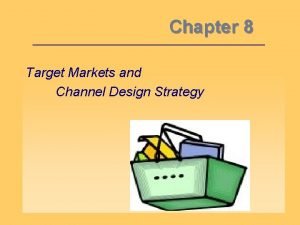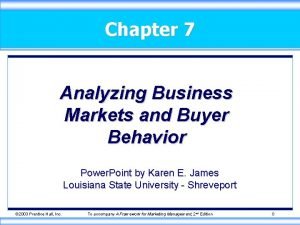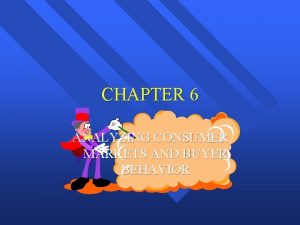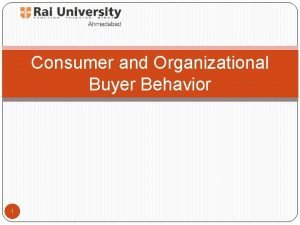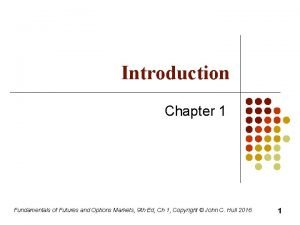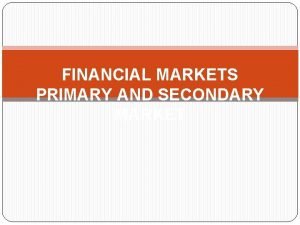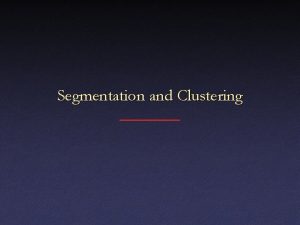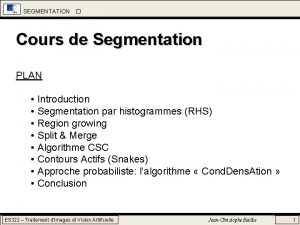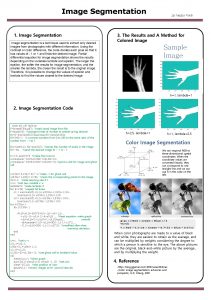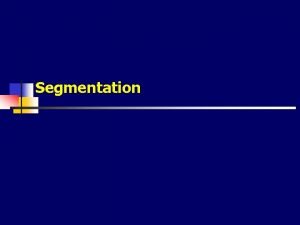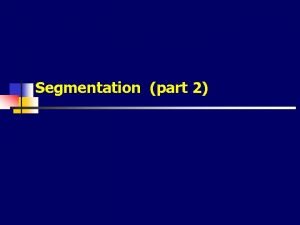Chapter 5 Target Markets Segmentation and Evaluation wecandGetty









































- Slides: 41

Chapter 5 Target Markets: Segmentation and Evaluation ©wecand/Getty. Images © 2015 Cengage Learning. All Rights Reserved. May not be scanned, copied or duplicated, or posted to a publicly accessible website, in whole or in part.

©wecand/Getty. Images Learning Objectives To understand what markets are and how they are generally classified To grasp an overview of the five steps of the target market selection process To understand the differences among general targeting strategies To become familiar with the major segmentation variables To know what segment profiles are and how they are used © 2015 Cengage Learning. All Rights Reserved. May not be scanned, copied or duplicated, or posted to a publicly accessible website, in whole or in part.

©wecand/Getty. Images Learning Objectives To understand how to evaluate market segments To identify the factors that influence the selection of specific market segments for use as target markets To become familiar with sales forecasting methods © 2015 Cengage Learning. All Rights Reserved. May not be scanned, copied or duplicated, or posted to a publicly accessible website, in whole or in part.

©wecand/Getty. Images Markets Groups of people, individuals or organizations that have: Desire or needs for products in a product class Ability, willingness, and authority to purchase such products Categories Consumer market: Purchasers and household members who intend to consume or benefit from the purchased products and do not buy products to make profits © 2015 Cengage Learning. All Rights Reserved. May not be scanned, copied or duplicated, or posted to a publicly accessible website, in whole or in part.

©wecand/Getty. Images Markets Business market: Purchase a specific kind of product for resale, direct use in producing other products and use in general daily operations Sub-classified into producer, reseller, government, and institutional markets © 2015 Cengage Learning. All Rights Reserved. May not be scanned, copied or duplicated, or posted to a publicly accessible website, in whole or in part.

©wecand/Getty. Images Figure 5. 1 - Target Market Selection Process © 2015 Cengage Learning. All Rights Reserved. May not be scanned, copied or duplicated, or posted to a publicly accessible website, in whole or in part.

©wecand/Getty. Images Step 1 - Identify Appropriate Targeting Strategy Target market - Consumers for whom a business creates and maintains a marketing mix Strategy selection for target market is affected by: Target market characteristics Product attributes Organization’s objectives and resources © 2015 Cengage Learning. All Rights Reserved. May not be scanned, copied or duplicated, or posted to a publicly accessible website, in whole or in part.

©wecand/Getty. Images Figure 5. 2 - Targeting Strategies © 2015 Cengage Learning. All Rights Reserved. May not be scanned, copied or duplicated, or posted to a publicly accessible website, in whole or in part.

©wecand/Getty. Images Types of Market and Market Segmentation Types of market Homogenous: Large proportion of customers have similar needs for a product Heterogeneous: Customers have diverse needs for products in a specific product class Market segmentation: Dividing a total market into groups with relatively similar product needs to design marketing mix Market segment: Customer base sharing one or more similar characteristics that cause them to have similar product needs © 2015 Cengage Learning. All Rights Reserved. May not be scanned, copied or duplicated, or posted to a publicly accessible website, in whole or in part.

Discussion Point • After 50 years of targeting only girls for its Easy-Bake Oven, Hasbro has announced a gender-neutral version and is airing commercials showing boys playing with the toy oven. • Does targeting children by gender reinforce stereotypes or limit play possibilities?

©wecand/Getty. Images Conditions For Market Segmentation To Succeed Customer’s needs must be heterogeneous Segments must be identifiable and divisible Marketer must be able to compare the different market segments In terms of sales potential, costs, and profits One segment must have enough profit potential to justify developing a special marketing mix Company must be able to reach the chosen segment with a particular marketing mix © 2015 Cengage Learning. All Rights Reserved. May not be scanned, copied or duplicated, or posted to a publicly accessible website, in whole or in part.

©wecand/Getty. Images Types of Targeting Strategies Undifferentiated targeting strategy • Designs a single marketing mix and directs it at the entire market for a particular product • Effective for homogenous markets Concentrated targeting strategy • Targets a single market segment using one marketing mix Differentiated targeting strategy • Targets two or more segments by developing a marketing mix for each segment © 2015 Cengage Learning. All Rights Reserved. May not be scanned, copied or duplicated, or posted to a publicly accessible website, in whole or in part.

©wecand/Getty. Images Advantages and Disadvantages of Concentrated Targeting Strategy Advantages Allows a firm to specialize Permits a firm with limited resources to compete with larger organizations Increases sales in the aggregate market Ideal for organization with excess production capacity Disadvantages Company’s financial health declines when the segment’s demand declines When a firm penetrates one segment its popularity may keep it from extending its marketing efforts into other segments Higher production cost © 2015 Cengage Learning. All Rights Reserved. May not be scanned, copied or duplicated, or posted to a publicly accessible website, in whole or in part.

©wecand/Getty. Images Step 2 - Determine Which Segmentation Variables to Use Segmentation variables: Characteristics of individuals, groups or organizations used to divide a market into segments Should relate to the customers’ needs for, uses of or behavior toward the product Must be measurable Company resources and capabilities affect the number and size of the variables Product type and degree variations in customer needs © 2015 Cengage Learning. All Rights Reserved. May not be scanned, copied or duplicated, or posted to a publicly accessible website, in whole or in part.

©wecand/Getty. Images Figure 5. 3 - Segmentation Variables for Consumer markets © 2015 Cengage Learning. All Rights Reserved. May not be scanned, copied or duplicated, or posted to a publicly accessible website, in whole or in part.

©wecand/Getty. Images Demographic Variables Age Gender Race and Ethnicity Income Family Life Cycle © 2015 Cengage Learning. All Rights Reserved. May not be scanned, copied or duplicated, or posted to a publicly accessible website, in whole or in part.

©wecand/Getty. Images Figure 5. 5 - Family Life Cycle Stages as a Percentage of All Households © 2015 Cengage Learning. All Rights Reserved. May not be scanned, copied or duplicated, or posted to a publicly accessible website, in whole or in part.

©wecand/Getty. Images Geographic Variables Climate and terrain City size and population density Urban area and rural area Market density: Number of potential customers within a unit of land area Useful segmentation variable for firms because lowdensity markets require different sales, advertising, and distribution activities than high-density markets © 2015 Cengage Learning. All Rights Reserved. May not be scanned, copied or duplicated, or posted to a publicly accessible website, in whole or in part.

Discussion Point Geographic Segmentation Climate affects numerous markets. Customers’ needs for automotive accessories, such as tires, vary based on climate.

©wecand/Getty. Images Geodemographic Segmentation Clusters people by zip codes or neighborhood units based on lifestyle and demographic in-formation Micromarketing: Focuses precise marketing efforts on very small geographic markets Climate - Geographic segmentation variable Impacts people’s behavior and product needs © 2015 Cengage Learning. All Rights Reserved. May not be scanned, copied or duplicated, or posted to a publicly accessible website, in whole or in part.

©wecand/Getty. Images Psychographic Variables Personality characteristics Product resembles many competing products Consumers’ needs are not significantly related to other segmentation variables Motives - Divides the market according to consumers’ reasons for making a purchase Lifestyle analysis - Characteristics related to people’s activities, interests, and opinions © 2015 Cengage Learning. All Rights Reserved. May not be scanned, copied or duplicated, or posted to a publicly accessible website, in whole or in part.

©wecand/Getty. Images Psychographic Variables: Lifestyle segmentation groups people by: How they spend their time The importance of things in their surroundings Beliefs about themselves and broad issues © 2015 Cengage Learning. All Rights Reserved. May not be scanned, copied or duplicated, or posted to a publicly accessible website, in whole or in part.

©wecand/Getty. Images VALS Classification Classifies consumers based on psychological characteristics correlated with: Purchase behavior Key demographics Used to determine lifestyle choices Used to create new products as well as segment existing markets © 2015 Cengage Learning. All Rights Reserved. May not be scanned, copied or duplicated, or posted to a publicly accessible website, in whole or in part.

©wecand/Getty. Images Behavioristic Variables Dividing a market according to consumer behavior toward a product in terms of its usage Used by marketers to satisfy customers who use a product in a certain way Involves designing certain product features in such a way that makes it easier to use, safer, or more convenient © 2015 Cengage Learning. All Rights Reserved. May not be scanned, copied or duplicated, or posted to a publicly accessible website, in whole or in part.

©wecand/Getty. Images Benefit Segmentation Division of a market according to benefits consumers want from the product Effectiveness depends on certain conditions Benefits sought must be identifiable Using the benefits, marketers must be able to divide people into recognizable segments One or more of the resulting segments must be accessible to the firm’s marketing efforts © 2015 Cengage Learning. All Rights Reserved. May not be scanned, copied or duplicated, or posted to a publicly accessible website, in whole or in part.

©wecand/Getty. Images Variables for Segmenting Business Markets Geographic location Type of organization Customer size Product use © 2015 Cengage Learning. All Rights Reserved. May not be scanned, copied or duplicated, or posted to a publicly accessible website, in whole or in part.

©wecand/Getty. Images Step 3 - Develop Market Segment Profiles Market segment profile Describes the similarities of potential customers within a segment Explains the differences among people and organizations in different segments Aspects covered Demographic and geographic factors Product benefits sought and lifestyles Brand preferences and usage rate © 2015 Cengage Learning. All Rights Reserved. May not be scanned, copied or duplicated, or posted to a publicly accessible website, in whole or in part.

©wecand/Getty. Images Uses of Market Segment Profile Assess the degree to which their products fit potential customers’ product needs Help marketers understand how a business can use its capabilities to serve potential customer groups Determine which segments are most attractive relative to the firm’s strengths, weaknesses, objectives, and resources Help a firm make marketing decisions relating to a specific market segment © 2015 Cengage Learning. All Rights Reserved. May not be scanned, copied or duplicated, or posted to a publicly accessible website, in whole or in part.

©wecand/Getty. Images Step 4 - Evaluate Relevant Market Segments Market Segment Aspects to be Evaluated Sales Estimates Competition Estimated Costs © 2015 Cengage Learning. All Rights Reserved. May not be scanned, copied or duplicated, or posted to a publicly accessible website, in whole or in part.

©wecand/Getty. Images Market Potential Total amount of a product customers will purchase within a specified period at a specific level of industry-wide marketing activity Stated in terms of dollars and units Affected by economic, soiciocultural and other environmental forces © 2015 Cengage Learning. All Rights Reserved. May not be scanned, copied or duplicated, or posted to a publicly accessible website, in whole or in part.

©wecand/Getty. Images Company Sales Potential Maximum percentage share of a market that an individual firm within an industry can expect to capture for a specific product Influencing factors Market potential - Limits the size of the company’s sales potential Magnitude of industry-wide marketing activities © 2015 Cengage Learning. All Rights Reserved. May not be scanned, copied or duplicated, or posted to a publicly accessible website, in whole or in part.

©wecand/Getty. Images Approaches to Measure Company Sales Potential Breakdown approach: Based on: General economic forecast for a specific period The market potential derived from it Buildup approach: Estimate product quantity a potential buyer in a specific geographic area will purchase in a given period Multiply the estimate by the number of potential buyers Add the totals of all the geographic areas considered © 2015 Cengage Learning. All Rights Reserved. May not be scanned, copied or duplicated, or posted to a publicly accessible website, in whole or in part.

©wecand/Getty. Images Step 5 - Select Specific Target Markets Investigate if the organization has sufficient: Financial resources Managerial skills Employee expertise Facilities to compete effectively in the selected segments Consider long-term versus short-term growth Conduct appropriate target market analysis © 2015 Cengage Learning. All Rights Reserved. May not be scanned, copied or duplicated, or posted to a publicly accessible website, in whole or in part.

©wecand/Getty. Images Developing Sales Forecasts Sales forecast: Amount of a product a company expects to sell during a specific period at a specified level of marketing activity Uses Planning Organizing Implementing Controlling activities © 2015 Cengage Learning. All Rights Reserved. May not be scanned, copied or duplicated, or posted to a publicly accessible website, in whole or in part.

©wecand/Getty. Images Executive Judgment Intuition of one or more executives Advantages • Expedient and inexpensive approach • Works well when product demand is stable Disadvantages • Forecast may weight recent sales booms or slumps excessively • Forecaster has only past experience as a guide for deciding where to go in the future © 2015 Cengage Learning. All Rights Reserved. May not be scanned, copied or duplicated, or posted to a publicly accessible website, in whole or in part.

©wecand/Getty. Images Forecasting Techniques Customer forecasting survey • Asking customers what types and quantities of products they intend to buy during a specific period Sales force forecasting survey • Firm’s salespeople estimate anticipated sales in their territories for a specified period Expert forecasting survey • Hiring professionals to help with sales forecast Delphi technique • Experts create initial forecasts, submit them to the company for averaging, and then refine the forecasts © 2015 Cengage Learning. All Rights Reserved. May not be scanned, copied or duplicated, or posted to a publicly accessible website, in whole or in part.

©wecand/Getty. Images Time Series Analysis Uses firm’s historical sales data to discover a pattern, or patterns, in sales over time Trend analysis: Focuses on aggregate sales data over a period of many years to determine general trends in annual sales Cycle analysis: Analysis of sales figures for a three- to five-year period to ascertain whether sales fluctuate in a consistent, periodic manner © 2015 Cengage Learning. All Rights Reserved. May not be scanned, copied or duplicated, or posted to a publicly accessible website, in whole or in part.

©wecand/Getty. Images Time Series Analysis Seasonal analysis: Analysis of daily, weekly, or monthly sales figures to evaluate the degree to which seasonal factors influence sales Random factor analysis: Attempts to attribute erratic sales variations to random, nonrecurrent events © 2015 Cengage Learning. All Rights Reserved. May not be scanned, copied or duplicated, or posted to a publicly accessible website, in whole or in part.

©wecand/Getty. Images Regression Analysis Predicting relationship between dependent variable and one or more independent variables Simple regression analysis - One independent variable Multiple regression analysis - Two or more independent variables Useful when: A precise association can be established Available historical sales data are extensive © 2015 Cengage Learning. All Rights Reserved. May not be scanned, copied or duplicated, or posted to a publicly accessible website, in whole or in part.

©wecand/Getty. Images Forecasting Techniques - Market Test Making a product available to buyers in one or more test areas and measuring purchases and consumer responses to marketing effort Advantages Disadvantages • Effective forecasting sales of new products or of existing products in new geographic areas • Gives a marketer an opportunity to test the success of various elements of the marketing mix • Time consuming and expensive • A marketer cannot be certain that consumer response during a market test represents the total market response, or that the same response will continue in the future © 2015 Cengage Learning. All Rights Reserved. May not be scanned, copied or duplicated, or posted to a publicly accessible website, in whole or in part.

©wecand/Getty. Images Multiple Forecasting Methods Used for marketing diverse product lines but Required for single product line when sold to different market segments Required due to variation in the length of forecasts © 2015 Cengage Learning. All Rights Reserved. May not be scanned, copied or duplicated, or posted to a publicly accessible website, in whole or in part.
 Target markets and channel design strategy
Target markets and channel design strategy Bases of market segmentation
Bases of market segmentation Primary target market and secondary target market
Primary target market and secondary target market Why study financial market
Why study financial market Characteristics of consumer behavior
Characteristics of consumer behavior Chapter 9 expanding markets and moving west
Chapter 9 expanding markets and moving west Buyer behaviour
Buyer behaviour Chapter 5 consumer markets and buyer behavior
Chapter 5 consumer markets and buyer behavior Chapter 5 consumer markets and buyer behavior
Chapter 5 consumer markets and buyer behavior Chapter 9 expanding markets and moving west
Chapter 9 expanding markets and moving west Chapter 9 expanding markets and moving west
Chapter 9 expanding markets and moving west Chapter 7 consumers producers and the efficiency of markets
Chapter 7 consumers producers and the efficiency of markets Chapter 4 cultural dynamics in assessing global markets
Chapter 4 cultural dynamics in assessing global markets Analyzing business markets chapter 7 ppt
Analyzing business markets chapter 7 ppt Chapter 18 the markets for the factors of production
Chapter 18 the markets for the factors of production Analyzing consumer markets
Analyzing consumer markets Firms in competitive markets chapter 14 ppt
Firms in competitive markets chapter 14 ppt Global consumer culture positioning example
Global consumer culture positioning example Chapter 6 implementation and evaluation
Chapter 6 implementation and evaluation Chapter 11 assessment and evaluation of sports injuries
Chapter 11 assessment and evaluation of sports injuries Financial intermediaries ppt
Financial intermediaries ppt Consumers producers and the efficiency of markets
Consumers producers and the efficiency of markets New markets tax credit 101
New markets tax credit 101 Business markets and business buyer behavior
Business markets and business buyer behavior Product market boundary structure
Product market boundary structure Financial institutions and markets lecture notes ppt
Financial institutions and markets lecture notes ppt Urban economics and real estate markets
Urban economics and real estate markets Sociology major dartmouth
Sociology major dartmouth Mutual fund flows and performance in rational markets
Mutual fund flows and performance in rational markets Types of financial intermediaries
Types of financial intermediaries Differentiate consumer behavior and organizational buyer
Differentiate consumer behavior and organizational buyer International financial markets and instruments
International financial markets and instruments Efficient capital markets and behavioral challenges
Efficient capital markets and behavioral challenges Consumers producers and the efficiency of markets
Consumers producers and the efficiency of markets Vertical and horizontal markets
Vertical and horizontal markets Capital markets and financial intermediation
Capital markets and financial intermediation Fundamentals of futures and options markets
Fundamentals of futures and options markets Methods of floatation in primary market
Methods of floatation in primary market Financial markets and the allocation of capital
Financial markets and the allocation of capital E-commerce: digital markets, digital goods
E-commerce: digital markets, digital goods Input and output market
Input and output market Types of exchange rate
Types of exchange rate
